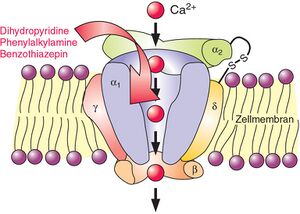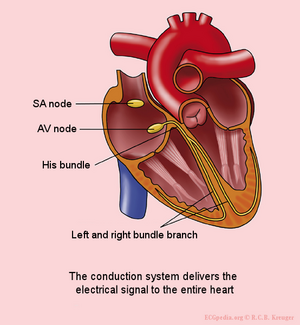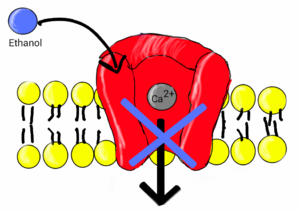Calcium Channel Blockers: Difference between revisions
No edit summary |
No edit summary |
||
| Line 5: | Line 5: | ||
</div> | </div> | ||
== Introduction == | == Introduction == | ||
[[File:CCB.jpeg|thumb|CCB in a cell membrane.]] | [[File:CCB.jpeg|thumb|CCB in a cell membrane.]] | ||
Calcium channel blockers (CCBs) are used in the management of [[hypertension]], [[Angina|angina pectoris]], supraventricular [[Heart Arrhythmias|arrhythmias]], [[Subarachnoid Hemorrhage (SAH)|subarachnoid hemorrhage]], [[Pulmonary Hypertension|pulmonary hypertension]], and for the prevention of [[Migraine Headache|migraine]]<ref>Gad SC. Phthalic Anhydride. Encyclopedia of Toxicology (Third Edition). 2014 Jan 1:934-6. Available:https://www.sciencedirect.com/topics/neuroscience/calcium-channel-blockers (accessed 29.3.2022)</ref>. | Calcium channel blockers (CCBs) are used in the management of [[hypertension]], [[Angina|angina pectoris]], supraventricular [[Heart Arrhythmias|arrhythmias]], [[Subarachnoid Hemorrhage (SAH)|subarachnoid hemorrhage]], [[Pulmonary Hypertension|pulmonary hypertension]], and for the prevention of [[Migraine Headache|migraine]]<ref>Gad SC. Phthalic Anhydride. Encyclopedia of Toxicology (Third Edition). 2014 Jan 1:934-6. Available:https://www.sciencedirect.com/topics/neuroscience/calcium-channel-blockers (accessed 29.3.2022)</ref>. | ||
| Line 13: | Line 12: | ||
Some calcium channel blockers can also slow the [[Heart Rate|heart rate,]] which can further lower [[Blood Pressure|blood pressure]]<ref>Mayo clinic CCBs Available:https://www.mayoclinic.org/diseases-conditions/high-blood-pressure/in-depth/calcium-channel-blockers/art-20047605 (accessed 29.3.2022)</ref>. | Some calcium channel blockers can also slow the [[Heart Rate|heart rate,]] which can further lower [[Blood Pressure|blood pressure]]<ref>Mayo clinic CCBs Available:https://www.mayoclinic.org/diseases-conditions/high-blood-pressure/in-depth/calcium-channel-blockers/art-20047605 (accessed 29.3.2022)</ref>. | ||
== | == Categories == | ||
[[File:Conduction system.png|right|frameless]] | |||
CCBs are often classify into two major categories, either non-dihydropyridines or dihydropyridines, based on their primary physiologic effects. | CCBs are often classify into two major categories, either non-dihydropyridines or dihydropyridines, based on their primary physiologic effects. | ||
| Line 19: | Line 19: | ||
# The dihydropyridines have a little direct effect on the myocardium, and instead, are more often peripheral vasodilators, and are useful for hypertension, post-intracranial hemorrhage associated vasospasm, and migraines.<ref>McKeever RG, Hamilton RJ. Calcium channel blockers.2018 Available: https://www.ncbi.nlm.nih.gov/books/NBK482473/<nowiki/>(accessed 30.3.2022)</ref> | # The dihydropyridines have a little direct effect on the myocardium, and instead, are more often peripheral vasodilators, and are useful for hypertension, post-intracranial hemorrhage associated vasospasm, and migraines.<ref>McKeever RG, Hamilton RJ. Calcium channel blockers.2018 Available: https://www.ncbi.nlm.nih.gov/books/NBK482473/<nowiki/>(accessed 30.3.2022)</ref> | ||
== | == Adverse Effects == | ||
[[File:Calcium channel blocker.png|thumb|Ethanol blocks voltage-gated CC|alt=]]Non-dihydropyridines may cause constipation, worsening cardiac output, and bradycardia. | |||
Dihydropyridines may lead to lightheadedness, flushing, headaches, and peripheral edema. | |||
Alcohol, combined with a calcium channel blocker, can cause severe side effects and may also affect the way the medication works.<ref>Everyday health What Are Calcium Channel Blockers? Available: https://www.everydayhealth.com/calcium-channel-blocker/guide/ (accessed 30.3.2022)</ref> | |||
== References == | == References == | ||
Revision as of 01:56, 30 March 2022
Original Editor - Lucinda hampton
Top Contributors - Wajeeha Hassan, Lucinda hampton and Kim Jackson
Introduction[edit | edit source]
Calcium channel blockers (CCBs) are used in the management of hypertension, angina pectoris, supraventricular arrhythmias, subarachnoid hemorrhage, pulmonary hypertension, and for the prevention of migraine[1].
They work by preventing calcium from entering the cells of the heart and arteries. Calcium causes the heart and arteries to contract more strongly. By blocking calcium, calcium channel blockers allow blood vessels to relax and open.
Some calcium channel blockers can also slow the heart rate, which can further lower blood pressure[2].
Categories[edit | edit source]
CCBs are often classify into two major categories, either non-dihydropyridines or dihydropyridines, based on their primary physiologic effects.
- The non-dihydropyridines have inhibitory effects on the sinoatrial (SA), and atrioventricular (AV) nodes resulting in a slowing of cardiac conduction and contractility. The are useful for the treatment of hypertension, reducing oxygen demand, and helps to control the rate in tachycardia.
- The dihydropyridines have a little direct effect on the myocardium, and instead, are more often peripheral vasodilators, and are useful for hypertension, post-intracranial hemorrhage associated vasospasm, and migraines.[3]
Adverse Effects[edit | edit source]
Non-dihydropyridines may cause constipation, worsening cardiac output, and bradycardia.
Dihydropyridines may lead to lightheadedness, flushing, headaches, and peripheral edema.
Alcohol, combined with a calcium channel blocker, can cause severe side effects and may also affect the way the medication works.[4]
References[edit | edit source]
- ↑ Gad SC. Phthalic Anhydride. Encyclopedia of Toxicology (Third Edition). 2014 Jan 1:934-6. Available:https://www.sciencedirect.com/topics/neuroscience/calcium-channel-blockers (accessed 29.3.2022)
- ↑ Mayo clinic CCBs Available:https://www.mayoclinic.org/diseases-conditions/high-blood-pressure/in-depth/calcium-channel-blockers/art-20047605 (accessed 29.3.2022)
- ↑ McKeever RG, Hamilton RJ. Calcium channel blockers.2018 Available: https://www.ncbi.nlm.nih.gov/books/NBK482473/(accessed 30.3.2022)
- ↑ Everyday health What Are Calcium Channel Blockers? Available: https://www.everydayhealth.com/calcium-channel-blocker/guide/ (accessed 30.3.2022)









